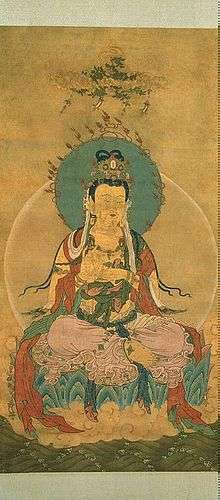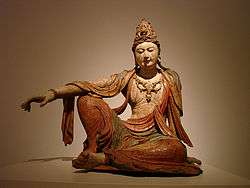Mahasthamaprapta
| Mahāsthāmaprāpta | |||||||||
 Mahāsthāmaprāpta | |||||||||
| Chinese name | |||||||||
|---|---|---|---|---|---|---|---|---|---|
| Traditional Chinese | 大勢至,得大勢 | ||||||||
| Simplified Chinese | 大势至,得大势 | ||||||||
| |||||||||
| Tibetan name | |||||||||
| Tibetan | Mthu-chen-thob | ||||||||
| |||||||||
| Vietnamese name | |||||||||
| Vietnamese alphabet | Đại Thế Chí Bồ tát | ||||||||
| Japanese name | |||||||||
| Kanji | 勢至 | ||||||||
| |||||||||
Mahāsthāmaprāpta is a bodhisattva mahāsattva that represents the power of wisdom, often depicted in a trinity with Amitābha and Avalokiteśvara (Guanyin), especially in Pure Land Buddhism. His name literally means "arrival of the great strength".
Mahāsthāmaprāpta is one of the Eight Great Bodhisattvas in Mahāyāna Buddhism, along with Manjushri, Samantabhadra, Avalokiteśvara, Akasagarbha, Kṣitigarbha, Maitreya and Sarvanivarana-Vishkambhin.
In Chinese Buddhism, he is usually portrayed as a woman, with a likeness similar to Avalokiteśvara. He is also one of the Japanese Thirteen Buddhas in Shingon. In Tibetan Buddhism (Tantrism), Mahāsthāmaprāpta is equated with Vajrapani, who is one of his incarnations and was known as the Protector of the Buddha.
Mahāsthāmaprāpta is one of the oldest bodhisattvas and is regarded as powerful, especially in the Pure Land school, where he takes an important role in the long Sutra of Infinite Life. He is also associated with the temple guardians Kongo Rikishi across Japan.
In the Shurangama Sutra, Mahāsthāmaprāpta tells of how he gained enlightenment through the practice of Buddha recitation, or continuous pure mindfulness of Amitābha, to obtain samādhi. In the Contemplation Sutra, Mahasthamaprapta is symbolised by the moon while Avalokiteśvara is represented by the sun.
Metaphorical manifestation
Monk Yinguang (印光), a teacher of the Pure Land School, was widely considered to be a metaphorical manifestation of Mahasthamaprapta after two people: 1. a Christian who had never heard of him before; and 2. a Chinese student of Monk Yinguang--both dreamed of that independently.[1][2][3]
References
- ↑ 净土的见证(一) Archived 2015-01-04 at the Wayback Machine.
- ↑ 共尊印光大师势至化身原因一_新浪佛学_新浪网
- ↑ 印祖的故事-海天佛国奇缘
Bibliography
- Getty, Alice (1914). The gods of northern Buddhism, their history, iconography, and progressive evolution through the northern Buddhist countries, Oxford: The Clarendon press, p.100.
